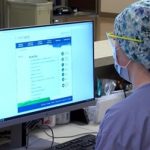Top Nurse Execs: These 3 Things Would Ease Nursing Crisis
 Burnout, violence and staffing shortages are just a few of the most pressing challenges the nation’s 4 million nurses are facing. It’s no question that these are pertinent to address across the healthcare sector nationwide, but what remains to be agreed upon is a clear path forward in doing so for compounding, complex issues.
Burnout, violence and staffing shortages are just a few of the most pressing challenges the nation’s 4 million nurses are facing. It’s no question that these are pertinent to address across the healthcare sector nationwide, but what remains to be agreed upon is a clear path forward in doing so for compounding, complex issues.
On Jan. 31, a panel of nursing executives from around the country gathered to speak about just that: What the path forward looks like.
Collectively, what the four panelists agreed on was the bottom line that if these issues are not adequately and promptly addressed, the shortage of nurses is likely to get worse. So, what happens if these issues are not addressed?
“There’s going to be a reduction in services that may be offered because there won’t be enough staff,” Ernest Grant, PhD, RN, former president of the American Nurses Association, said during the panel, which was facilitated by U.S. News & World Report. “You then have to weigh, where can we either continue to cut corners or cut services that a facility may offer in order to still have enough adequate staff to provide the expert care that is required. And less staff also means that you’re going to have overworked staff, which means that we also have to be concerned about the potential of errors that could occur as a result.”
Three key solutions that Dr. Grant and panelists Gail Vozzella, DNP, RN, senior vice president and chief nurse executive of Houston Methodist Hospital; Suzanne Algeri, RN, the associate chief nurse at Boston-based Massachusetts General Hospital; and Iman Abuzeid, MD, CEO of Incredible Health, outlined include investing in technology, listening to nurses, and creating ease for current and future nursing students.
Improve the technology
Partnering with technologists and vendors that offer solutions for nursing workflows is key to improving efficiency, Dr. Vozzella said. Improving online medical records systems to quickly update in the event of care handoff is one thing that would be enormously helpful to both nurses and patients, she noted.
“Nurses need to quickly see the information they need to take care of their patient so that if we hand off care, there’s no disruption in that patient’s care,” she said.
Dr. Vozzella added that technology will also improve other areas of the profession, like scheduling. Rather than being within the walls of their unit to adjust schedules, she said they should be given the same flexibility other professions are.
“Treating nurses like professionals, that they can have ease of technology in order to adjust schedules to meet their family needs,” she said. “They should be able to pull the schedule up on their phone because they had something happen in their life and need to adjust their schedules.”
Listen to nurses
A key component of finding solutions to the ongoing crises that face the profession, panelists underscored, is for leaders to listen to them and ask what they need.
“Nurses want to be heard,” Ms. Algeri said. “They want to feel valued and they want to know they have support and advocacy.”
As the key care staff in hospital rooms, nurses know what is needed and where, she commented, so asking what resources nurses need is also important.
Make things easier for nursing students
Support with student loans, better pay, programming and improved technology within nursing programs is also vital to pay attention to and attract more individuals to the profession, panelists said.
Encouraging mentorship and also finding increased faculty to work with and invest time in nursing students will help fuel the pipeline going forward, Dr. Grant said, but it will have to be done on a national level.
“One of the biggest problems is that there’s not enough faculty to help if we want to increase the enrollment of students,” he said. “We need to make certain that, you know, the funding that the federal government or even the state governments may be setting aside is going to be used to help better that particular situation.”
(This story originally appeared in Becker’s Hospital Review.)




